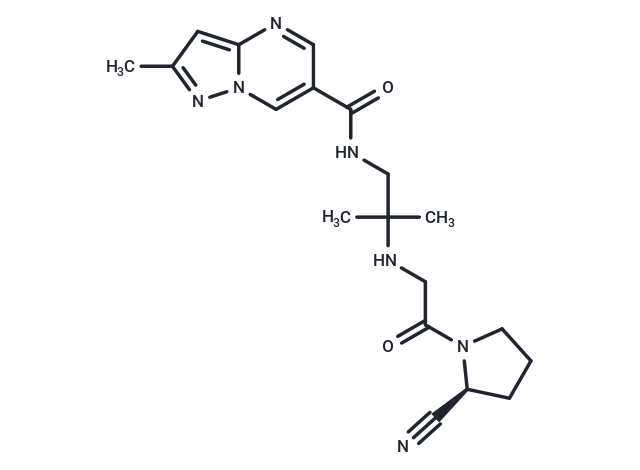Shopping Cart
Remove All Your shopping cart is currently empty
Your shopping cart is currently empty
Anagliptin (SK-0403) is a potent inhibitor of DPP-4 (IC50 of 3.8 nM) used in the treatment of type 2 diabetes mellitus.

| Pack Size | Price | USA Warehouse | Global Warehouse | Quantity |
|---|---|---|---|---|
| 1 mg | $39 | In Stock | In Stock | |
| 5 mg | $93 | In Stock | In Stock | |
| 10 mg | $139 | In Stock | In Stock | |
| 25 mg | $235 | In Stock | In Stock | |
| 50 mg | $349 | In Stock | In Stock | |
| 100 mg | $529 | In Stock | In Stock | |
| 200 mg | $753 | - | In Stock | |
| 1 mL x 10 mM (in DMSO) | $98 | In Stock | In Stock |
| Description | Anagliptin (SK-0403) is a potent inhibitor of DPP-4 (IC50 of 3.8 nM) used in the treatment of type 2 diabetes mellitus. |
| Targets&IC50 | DPP8:68 nM , DPP9:60 nM, DPP4:3.8 nM |
| In vitro | Soluble DPP-4 augmented cultured SMC proliferation, and anagliptin suppressed the proliferation by inhibiting ERK phosphorylation.?In THP-1 cells, anagliptin reduced lipopolysaccharide-induced TNF-α production with inhibiting ERK phosphorylation and nuclear translocation of nuclear factor-κB.?Quantitative analysis also showed that anagliptin reduced the area of atherosclerotic lesion in apoE-deficient mice[1]. |
| In vivo | Treatment with anagliptin for 16 wk significantly reduced accumulation of monocytes and macrophages in the vascular wall, SMC content in plaque areas, and oil red O-stained area around the aortic valve without affecting glucose tolerance or body weight.?Serum DPP-4 concentrations were significantly higher in apoE-deficient mice than control mice, and the levels increased with aging, suggesting the involvement of DPP-4 in the progression of atherosclerosis[1]. Anagliptin treatment significantly decreased the plasma total cholesterol (14% reduction, P < 0.01) and triglyceride levels (27% reduction, P < 0.01). Both low-density lipoprotein cholesterol and very low-density lipoprotein cholesterol were also decreased significantly by anagliptin treatment. Sterol regulatory element-binding protein-2 messenger ribonucleic acid expression level was significantly decreased at night in anagliptin-treated mice (15% reduction, P < 0.05). Anagliptin significantly suppressed sterol regulatory element-binding protein activity in HepG2 cells (21% decrease, P < 0.001)[2]. |
| Animal Research | Male low-density lipoprotein receptor-deficient mice were administered 0.3% anagliptin in their diet.?Plasma lipid levels were assayed and lipoprotein profile was analyzed using high-performance liquid chromatography.?Hepatic gene expression was examined by deoxyribonucleic acid microarray and quantitative polymerase chain reaction analyses[2]. |
| Synonyms | SK-0403 |
| Molecular Weight | 383.45 |
| Formula | C19H25N7O2 |
| Cas No. | 739366-20-2 |
| Smiles | Cc1cc2ncc(cn2n1)C(=O)NCC(C)(C)NCC(=O)N1CCC[C@H]1C#N |
| Relative Density. | 1.33 g/cm3 (Predicted) |
| Color | White |
| Appearance | Solid |
| Storage | Powder: -20°C for 3 years | In solvent: -80°C for 1 year | Shipping with blue ice/Shipping at ambient temperature. | |||||||||||||||||||||||||||||||||||
| Solubility Information | DMSO: 50 mg/mL (130.4 mM), Sonication is recommended. | |||||||||||||||||||||||||||||||||||
| In Vivo Formulation | 10% DMSO+40% PEG300+5% Tween 80+45% Saline: 2 mg/mL (5.22 mM), Sonication is recommended. Please add the solvents sequentially, clarifying the solution as much as possible before adding the next one. Dissolve by heating and/or sonication if necessary. Working solution is recommended to be prepared and used immediately. The formulation provided above is for reference purposes only. In vivo formulations may vary and should be modified based on specific experimental conditions. | |||||||||||||||||||||||||||||||||||
Solution Preparation Table | ||||||||||||||||||||||||||||||||||||
DMSO
| ||||||||||||||||||||||||||||||||||||
| Size | Quantity | Unit Price | Amount | Operation |
|---|

Copyright © 2015-2025 TargetMol Chemicals Inc. All Rights Reserved.